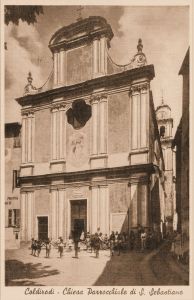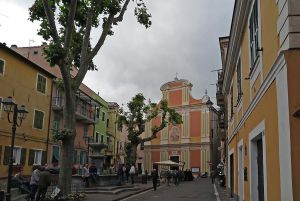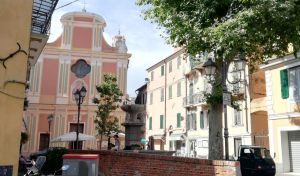Parish church of Coldirodi
Some historians say that the present day village of Poggio Pino or Poipino, a locality in the Pietralunga region, was destroyed by the barbarians in 1316. The village was immediately provided with a small chapel, presumably founded in 1319 immediately after the construction of the first houses on the hill, and dedicated to the patron saint against the plague.
Until 1449 on the territory of Civitas Sancti Romuli there was only one parish church, with its baptismal font, and it was San Siro outside the walls. However, given that it was no longer sufficient to contain the increased population, at the request of the two massari of the chapel, Giacomo Anfosso and Giovanni Calvino, after hearing the favourable opinion of the prelate of San Siro Giovanni Battista Gioffredo and considering the fact that the children, brought to Sanremo during the winter to receive baptism, could die along the way, and  that the other sacraments were administered with great discomfort for the local population, the prelate ingauno accepted the request of the collantini.
that the other sacraments were administered with great discomfort for the local population, the prelate ingauno accepted the request of the collantini.
On the 9th January 1494 the bishop of Albenga issued the decree with which the church of San Sebastiano di Coldirodi was officially erected as a parish, and the area of Solaro was then assigned by decree to the jurisdiction of the collantine parish. The first rector and creator of the division was the priest Romolo Calvini. The maintenance of the new Parish provided for the Bishop who, as Lord of the territory under the jurisdiction of the Church, ordered the mayors, the massari and the inhabitants of the Rhodes Valley to commit themselves to pay an annual fee, in addition to the tithes agreed upon by all the heads of the Colla family, to provide the new church with the necessary income.
The collection of these tithes, however, would have caused a long series of misunderstandings and disputes between the provost and the canons of San Siro, which would have worsened especially during the seventeenth century, due to the drastic reduction in the ecclesiastical taxes paid by local farmers on the land cultivated in more recent times than those of their ancestors.
 However, the practice initiated by the bishop's decree was not quickly resolved, as the definitive separation of the property of the two churches of San Siro and San Sebastiano would only be regulated by a decree issued by the community of Coldirodi on 18 August 1549 regarding the payment of the canon due by the collantina parish to the church of San Siro.
However, the practice initiated by the bishop's decree was not quickly resolved, as the definitive separation of the property of the two churches of San Siro and San Sebastiano would only be regulated by a decree issued by the community of Coldirodi on 18 August 1549 regarding the payment of the canon due by the collantina parish to the church of San Siro.
The previous chapel of 1319 was rebuilt as the seat of the parish church and the Bishop of Albenga Leonardo Marchesi consecrated the new building on 20th August 1505. The church after a further enlargement following the very serious plague that had hit the town in 1491, had fallen into ruin immediately after the earthquake that occurred in the same year of the consecration by the prelate ingauno, so much so that a new total renovation of the sacred building was not postponed.
On 26th June 1616 the first stone of the new church was laid, then finished within twelve years and solemnly blessed on 6th January 1628.
Other constructions were carried out in 1643, when the Town Council allocated the sum of one hundred liras to finance the church building, while in 1708 other one hundred liras were paid as reimbursement to the consuls of Colla who had had the house built for the rector of the church. In 1636 it was enlarged and embellished. Other expenses for the parish church were incurred in 1728, 1736, 1737 and 1744, with a rather substantial overall disbursement totally borne by the local population.
After the separation from the community from Sanremo in 1753, the inhabitants of Colla, under the direction of the provost Giorgio Donato Rodi, who had taken over the functions of parish priest after the death of the rector of the church Giovanni Battista Semeria, called Boso, also in order to guarantee a greater capacity of the building and give it a more imposing appearance, undertook some grandiose works to enlarge the structure. The church was therefore lengthened with the demolition of some houses situated behind the bottom of the building, where the large apse area was raised in the area that remained free, while in 1750 forty liras were allocated for the repair of the bell tower next to the church, which the collantini wanted particularly slender and imposing.
The long and demanding enlargement of the sacred building was supported by the whole population, who contributed with the usual free shifts, while the main representatives of the secular and religious authorities of the town, who supported the massive enlargement of the building, were the massari of the church and the councillors.
The enlargement of the church also required richer and more sumptuous furnishings and ornaments, so that the Municipality spent between 1764 and 1769 the sum of 3,682 lire for the purchase of the organ, a silver cross for the processions, lamps and a reliquary of Saints Ignatius and Sebastian. In the following years other purchases were made in order to obtain the tapestries for the decoration of the walls on the occasion of the main festivities. In 1761 the presbytery with the choir was built by the parish priest Don Giorgio Donato Rodi, the first to boast the title of "provost", while in October 1772 a solemn procession was held to receive the remains of the martyr Saint Fortunato in a dignified manner, transferred to the parish church from the church of San Bernardo, where they were initially placed immediately after their arrival from Rome, among the jubilation of the local population particularly devoted to the martyr saint, whose intercession was also attributed to a miraculous healing that took place during the days of his transfer to the collantina parish.
In 1761 the presbytery with the choir was built by the parish priest Don Giorgio Donato Rodi, the first to boast the title of "provost", while in October 1772 a solemn procession was held to receive the remains of the martyr Saint Fortunato in a dignified manner, transferred to the parish church from the church of San Bernardo, where they were initially placed immediately after their arrival from Rome, among the jubilation of the local population particularly devoted to the martyr saint, whose intercession was also attributed to a miraculous healing that took place during the days of his transfer to the collantina parish.
Inside the church, with the works in the nave made in 1858 by the Ticinese plasterer Andrea Adami with pure gold, there are numerous works, including the high altar, an altarpiece in Baroque style, now transferred to the sacristy, depicting St. Sebastian with St. Joseph and the Evangelist; the fresco of the vault above the choir, representing St. Sebastian in glory, painted by Maurizio Carrega (1737 - after 1819); a Pietà, made by an unknown Italian artist of the 18th century, placed on the wall to the left of the high altar in the presbyterial area and an Angel, also made by an unknown artist, a wooden altar of refined workmanship applied on a turtle cross with carved decoration of friezes and arabesques particularly showy and elegant.
Other significant works include the fourteen paintings of a Way of the Cross made in western Liguria in the 18th century, an artistic statue of St. Sebastian attributed to the Genoese sculptor Anton Maria Maragliano (1664-1741); an ivory Crucifix and relics of various saints and martyrs, including those of St. Martian. Among the relics we would like to point out in particular those made up of bone particles belonging to some martyred popes, preserved in an artistic
gilded metal spire and object of special veneration by Pope Pius VI.
Of the various paintings inside the church, the Madonna and Child Jesus and Saints, painted by an anonymous Italian painter in the 19th century and placed on the right wall of the high altar in the presbytery area; the Madonna intercedes for purgative souls, painted in western Liguria during the 18th century, located on the left wall of the third altar in the nave; the Holy Family and Saints,
work by an unknown artist from Ponente in the 18th century placed on the right wall of the second altar in the nave; and a Madonna Assunta, also made in the 18th century by an unknown painter from western Liguria and placed on the back wall of the third altar on the right side of the nave.
The most important sculptures in the church are the statue of the titular saint attributed to Maragliano, the statue of St. Peter, produced by an Italian artisan workshop during the nineteenth century and placed in the centre of the altar of the second chapel on the left wall of the nave; the sculpture of the Risen Christ, equipped with a golden halo, made by an anonymous artist from western Liguria in the 17th century on the selvedge of the altar situated on the back wall of the second chapel on the left side of the nave; and a dead Christ, the work of an unknown 18th century Ponentine sculptor, placed in a niche in the access space to the presbytery on the right wall of the nave.
Finally, the church is equipped with a large organ, built by Natale Marelli's firm in Milan in 1910 and located in the wooden chancel located above the main entrance inside a painted, decorated and equipped with doors, which in turn was inserted in another pre-existing one dating back to the 18th century.
In the 21st century the marble balustrade was made.
(sources: Ernesto Porri; Andrea Gandolfo)




